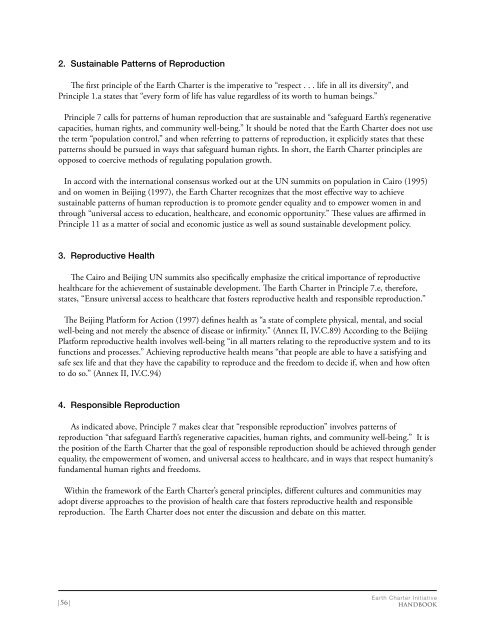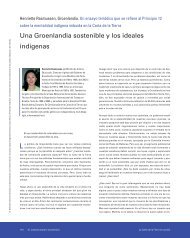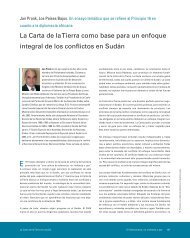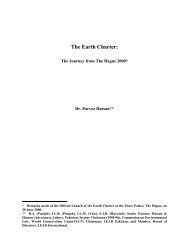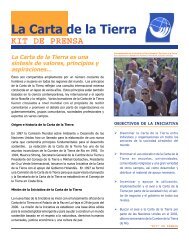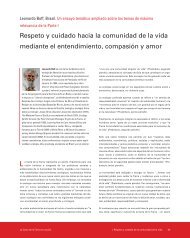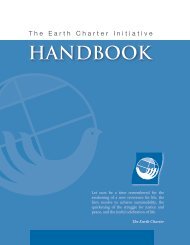Handbook English - Earth Charter Initiative
Handbook English - Earth Charter Initiative
Handbook English - Earth Charter Initiative
You also want an ePaper? Increase the reach of your titles
YUMPU automatically turns print PDFs into web optimized ePapers that Google loves.
2. Sustainable Patterns of Reproduction<br />
The first principle of the <strong>Earth</strong> <strong>Charter</strong> is the imperative to “respect . . . life in all its diversity”, and<br />
Principle 1.a states that “every form of life has value regardless of its worth to human beings.”<br />
Principle 7 calls for patterns of human reproduction that are sustainable and “safeguard <strong>Earth</strong>’s regenerative<br />
capacities, human rights, and community well-being.” It should be noted that the <strong>Earth</strong> <strong>Charter</strong> does not use<br />
the term “population control,” and when referring to patterns of reproduction, it explicitly states that these<br />
patterns should be pursued in ways that safeguard human rights. In short, the <strong>Earth</strong> <strong>Charter</strong> principles are<br />
opposed to coercive methods of regulating population growth.<br />
In accord with the international consensus worked out at the UN summits on population in Cairo (1995)<br />
and on women in Beijing (1997), the <strong>Earth</strong> <strong>Charter</strong> recognizes that the most effective way to achieve<br />
sustainable patterns of human reproduction is to promote gender equality and to empower women in and<br />
through “universal access to education, healthcare, and economic opportunity.” These values are affirmed in<br />
Principle 11 as a matter of social and economic justice as well as sound sustainable development policy.<br />
3. Reproductive Health<br />
The Cairo and Beijing UN summits also specifically emphasize the critical importance of reproductive<br />
healthcare for the achievement of sustainable development. The <strong>Earth</strong> <strong>Charter</strong> in Principle 7.e, therefore,<br />
states, “Ensure universal access to healthcare that fosters reproductive health and responsible reproduction.”<br />
The Beijing Platform for Action (1997) defines health as “a state of complete physical, mental, and social<br />
well-being and not merely the absence of disease or infirmity.” (Annex II, IV.C.89) According to the Beijing<br />
Platform reproductive health involves well-being “in all matters relating to the reproductive system and to its<br />
functions and processes.” Achieving reproductive health means “that people are able to have a satisfying and<br />
safe sex life and that they have the capability to reproduce and the freedom to decide if, when and how often<br />
to do so.” (Annex II, IV.C.94)<br />
4. Responsible Reproduction<br />
As indicated above, Principle 7 makes clear that “responsible reproduction” involves patterns of<br />
reproduction “that safeguard <strong>Earth</strong>’s regenerative capacities, human rights, and community well-being.” It is<br />
the position of the <strong>Earth</strong> <strong>Charter</strong> that the goal of responsible reproduction should be achieved through gender<br />
equality, the empowerment of women, and universal access to healthcare, and in ways that respect humanity’s<br />
fundamental human rights and freedoms.<br />
Within the framework of the <strong>Earth</strong> <strong>Charter</strong>’s general principles, different cultures and communities may<br />
adopt diverse approaches to the provision of health care that fosters reproductive health and responsible<br />
reproduction. The <strong>Earth</strong> <strong>Charter</strong> does not enter the discussion and debate on this matter.<br />
|56|<br />
<strong>Earth</strong> <strong>Charter</strong> <strong>Initiative</strong><br />
HANDBOOK


